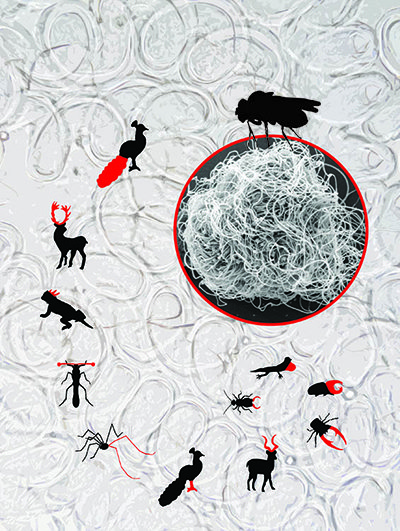Forget Peacock Tails—Fruit Fly Sperm Tails Are the Most Extreme Ornaments
New paper in Nature explains why ornament may have evolved

When it comes to mating, male animals show off the flashiest of ornaments to convince females of their suitability. A peacock’s ornate tail may be the best-known example of a mate-attracting ornament, but a new study finds that peacock tails have nothing on a tail of another kind. Sperm tails in fruit flies are the most extreme ornament ever described.
Sperm having ornaments may come as a surprise, considering humans’ relatively simple tadpole-like cells. However, the animal kingdom is host to an incredible diversity of sperm forms, explains Scott Pitnick, the lead author of a new study in Nature and Weeden Professor of Biology in the College of Arts and Sciences. Think sperm with multiple tails, no tails at all or in the case of one fruit fly, sperm that are nearly 6 cm long—roughly a thousand times longer than a human sperm cell.
“A question I’ve been fascinated with since grad school is why do some species have males that produce few, giant sperm,” Pitnick says. To answer this, he and coauthors looked at a group of fruit flies that produce unusually long sperm. Similar to the majority of animals, female flies mate with more than one male, meaning that a flashy courtship display isn’t enough to guarantee a male will fertilize eggs. Sperm from different males continue to compete inside females.
The basic reason that animals produce extreme sperm is similar to the reason males evolve any type of flashy ornaments: because females prefer them. “Crazy sperm forms are evolving because female reproductive tracts are evolving that bias fertilization in favor of these weird, specific traits,” Pitnick says, pointing to a female’s active role in selecting preferred sperm after mating. In fruit flies, long female sperm storage organs give a boost to males producing longer sperm. He continues, “The problem is, for any kind of male ornament, it’s been a challenge to figure out why those female preferences arise and evolve. That’s the big, difficult question in sexual selection theory.”

Pitnick’s study, coauthored by researchers from University of Zurich, The George Washington University and National University of Singapore, suggests a two-part explanation for why female flies prefer such extreme sperm. “First, we have this perfect storm of genetic correlations that are driving all of these female preference, male ornament and mating system traits forward,” Pitnick says. The team found a genetic relationship between the length of a female’s sperm storage organ and male’s sperm length, meaning when one trait evolves to be longer, the other follows in kind. Additionally, genes for long organs were associated with genes for faster remating by females, which further increases competition among sperm and hence the advantage to males producing longer sperm.
The second part of the explanation involves an association between male quality and the number of sperm produced. There is a trade-off between sperm length and sperm number. “When sperm are short and cheap to make, any male can produce lots of them. However, as sperm evolve to be longer, only those males in the best health—those with good genes—can make large numbers of them and so capitalize on all the female remating. This too strengthens the female preference for longer sperm, as they get good genes to pass on to their offspring.”
In light of these extreme sperm traits and their importance to reproductive success, Pitnick hopes traits that influence fertilization success will get their time in the spotlight. “When you think about sex differences, people typically are thinking about gaudy males with dramatic courtship dances and females that are drab and demure. What they should be thinking of is sperm and eggs, because that represents the more fundamental difference between the sexes.” He continues, “When you’re thinking about outrageous ornaments that differentiate males and females, you should also be thinking about sperm first.”
Their paper, titled “How sexual selection can drive the evolution of costly sperm ornamentation,” is published in Nature: http://dx.doi.org/10.1038/nature18005.
